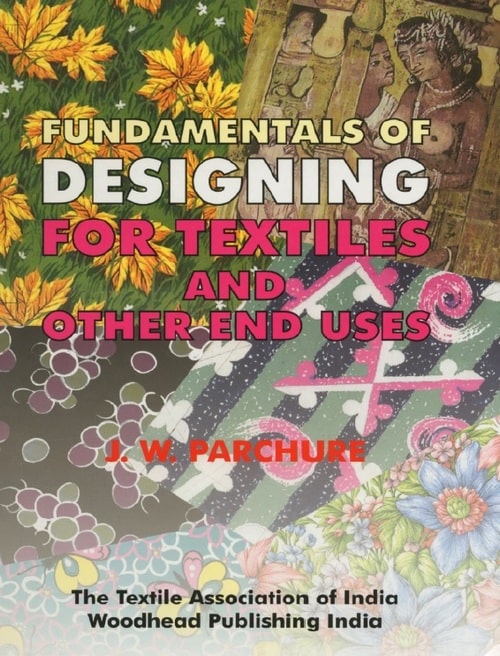
CONTENTS
1. Introduction 08
2. Collection of References as Raw Material 09
3. Materials you need 11
4. Difference between Textile & other designs 11
5. Percentage of Covered Area in Design 12
6. Elements of Textile Design 13
7. Methods of Reproduction of Designs and Concept of Repeat 14
8. Preparation of Motifs for Designs 17
9. Designs for Borders 18
10. Basic Compositions for allover Designs 20
11 . One More Method of transferring Motif on Repeat 21
12. Allover Designs (Contd.) 22
13. More Diagrams for allover Designs 28
14. The Colou r Wheel 28
15. Colour Wheel in Action 29
16. Backgrounds 30
17. Half-Drops 31
18. Step Down Repeats 33
19. Discharge Prints 35
End Products 36
20. Dress Materials 37
21. Neck-Tie 38
22. Handkerchiefs 39
23. Dress Materials – Skirts 41
24. Indian Saree 43
25. Tee-Shirts 45
26. Towels and Napkins 46
27. Socks 47
28. Cushion Cover and Pillow Case 49
29. Table Cloth and Table Cover 51
30. Bed Sheet and Bed Spread 53
31. Umbrella 55
32. Tote Bags 56
33. Tapestries , Curtains, Furnishing Fabrics , Wall Hangings, etc. 57
34. Carpets 61
35. Floor Mats 63
36. Cross-stitch and Embroidery 64
37. Lace Designs 67
Other Similar Products
38. Linoleum 70
39. Wall Papers 71
40. Wrapping Material and End Paper for Book binding 73
41. Lapmates, Placemats and Doormats 75
42. Computer aided Designs 76
End of the Beginning 79
PREFACE
Unless and until the human race feels shy of covering itself with some kind of fabric, the textile industry will go on performing its role in the civilization, as it has been, till this day. But it is also the duty of the artists’ community to save the mankind from such disastrous temptation towards modern primitivity, by continuously producing attractive textile designs, and desist the susceptible species from jumping into the hell-pit of that temptation. I hope, this book though infinitesimally, will help in that great cause.
Since its inception – from the time man first learned to wrap animal skin around his body for warmth – the textile industry has undergone tremendous developments in all its branches. Textiles fulfill not only primary need of protecting human body in all seasons, but also serves to decorate it. The idea of display entered the imaginative human brain and the concept of ‘DESIGN’ was born .
Studying as an art student in Model Art Institute, Mumbai, I came across some books titled ‘How to Draw’. Those books fascinated me, but the idea of preparing a book on textile designing dawned five six years after I left the job of a textile designer. I still wonder how and why a book on textile designing was not available before, the industry being age old notwithstanding.
Unexpectedly ,one day the question struck me from within, “Why not yourself?” The germination of this idea made me restless, compelling me to fold my sleeves and take it up. I was aware it was not so an easy task.
Considerable spadework was necessary as no book devoted entirely to this subject was available. In the system prevailing earlier, and even at present, any novice aspiring for the career of a textile designer has to find a tracer’s job in some textile printing house or with a screen maker, observe the designer at work, and try to learn. If that designer is willing to guide, well!, novice would be lucky. Otherwise the learning is somewhat difficult. Mere observation may open the door, but only partly.
Considering the needs of the student, I have planned my book to help him/her to learn the designing with ease. The script, the diagrams of constructions, motifs are all kept simple, and so are the different colour schemes. The student, by studying the sample designs from every chapter, like examples in arithmatic and grammar, should try to create his/her own designs in any size from monochromatics to multicolours. Simple motifs have been purposely selected to instill confidence in the student. He/she should be able, not only to copy them in his / her designs, but also meliorate them if he / she wished so.
The basic constructions of designs for wallpaper, linoleum (Floor Covering) and wrapping material being the same as textile designs, are covered in this book. Chapters on needlework (socks, embroidery and lace designs) are also included, being an interesting and substantial part of textiles. Suitable designs for end uses are also inserted to make the student more informed.
Though the textile design is presently taught in many art institutions, the absence of some kind of a text book dealing entirely with textile design is still present. This book, I hope, will prove useful in filling that gap. It will be useful not just to the students of all colleges that teach textile designing in one or other context, but also the practicing designers working in the field of textiles, wall papers and Floor covers.
I feel really happy, that the concept of this book ideated in my mind &I could carry itthrough.
I will be ingrate, if I forget those who helped me in this book writing project.
